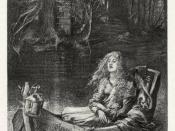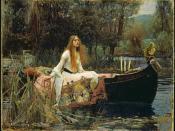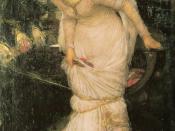The Pre-Raphaelites often characterized women destroyed by love, namely emphasizing the mental distress and sexual frustration of the fallen woman. The Lady of Shalott by Lord Alfred Tennyson is one of the prime examples of a fallen woman in the Victorian Era. Locked in a tower, cursed to carry out her life of tapestry-weaving, The Lady of Shalott meets her inevitable demise upon leaving her quarters in an effort to relieve her loneliness and lust. Marked by the death of Alfred Tennyson and the completion of the large scale, oil version of its main illustration by William Holman Hunt, the year of 1892 unleashed a new birth of women equality. The aftermath of Tennyson's poem and its illustration is a noted retaliation of women due to the desire to leave her respected, domestic sphere, to become cultivated intellects, and to acquire the same rights of their male counterparts. These revolutionary feminist concepts are repeatedly reflected in the satirical Victorian magazine, Punch or The London Charivari.
By analyzing the history of this notorious painting, the Pre-Raphaelite poses relating to feminism, the medieval and Arthurian nature of the painting in relation to fairy tales, the significance of Tennyson's passing, and the reaction to the backlash, we can clearly see that Hunt's painting of The Lady of Shalott influenced not only Punch but the entire nature of women, in general.
To begin, the referenced version of Hunt's The Lady of Shalott holds a history and meaning unparalleled to most paintings. Most significantly, this was the final painting completed by Hunt before passing away in 1910 (Stilo, par. 2). The finished product of this painting is derived from its 1857 engraving as seen in the Moxon Tennyson. The final oil version of The Lady of Shalott was started in 1886, finished in 1892, and...


